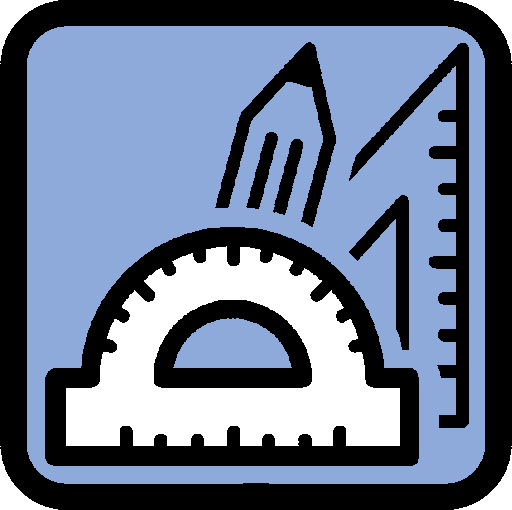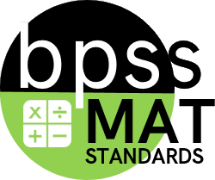MAT-00.GM  MAT-00.GM MAT-00.GM Domain  | (GM) Geometry and Measurement Learners will use visualization, spatial reasoning, and geometric modeling to investigate the characteristics of figures, perform transformations, and construct logical arguments.
|
Sub-Categories- (G) Geometry
Learners will compose and classify figures and shapes based on attributes and properties; represent and solve problems using a coordinate plane. - (M) Measurement
Learners will represent and calculate measurement data, including time, money, and geometric measurement, and convert like measurement units within a given system.
- (AV) Area and Volume
Learners will use visualization and spatial reasoning to solve problems involving the area, surface area, and volume of geometric figures. - (GF) Geometric Figures
Learners will use visualization, spatial reasoning, and geometric modeling to investigate the characteristics of figures, perform transformations, and construct logical arguments.
Calculation Method for DomainsDomains are larger groups of related standards. The Domain Grade is a calculation of all the related standards. Click on the standard name below each Domain to access the learning targets and rubrics/ proficiency scales
for individual standards within the domain. |
|
MAT-00.GM.G.01

|
Kindergarten (MAT) Targeted Standard
(GM) Geometry and Measurement
(G) Geometry
Learners will compose and classify figures and shapes based on attributes and properties; represent and solve problems using a coordinate plane.
|
MAT-00.GM.G.01 Name shapes and identify them as two-dimensional regardless of their orientations or overall sizes.*
 Proficiency Scale Proficiency Scale
Progressions
Two-Dimensional Shapes
- MAT-00.GM.G.01 Name shapes and identify them as two-dimensional (squares, circles, triangles, rectangles)regardless of their orientations or overall size.
- MAT-00.GM.G.03 Compare and classify two-dimensional shapes to describe their similarities, differences, and attributes (squares, circles, triangles, rectangles).
- MAT-01.GM.G.01 Name shapes and identify them as two-dimensional (trapezoids, rhombuses, pentagons, hexagons, octagons).
- MAT-01.GM.G.03 Determine geometric attributes of two-dimensional and three-dimensional shapes.
- MAT-02.GM.G.01 Identify two-dimensional shapes (parallelograms and quadrilaterals).
- MAT-02.GM.G.03 Compose geometric shapes having specified geometric attributes, such as a given number of edges, angles, faces, vertices, and/or sides.
- MAT-03.GM.G.01 In two-dimensional shapes, identify lines, angles (right, acute, obtuse), and perpendicular and parallel lines.
- MAT-03.GM.G.02 Sort quadrilaterals into categories based on attributes.
- MAT-04.GM.G.01 Identify, label, and draw points, lines, line segments, rays, and angles (right, acute, obtuse).
- MAT-04.GM.G.02 Classify two-dimensional figures based on the presence or absence of parallel or perpendicular lines or the presence or absence of angles of specified size.
- MAT-05.GM.G.01 Classify two-dimensional figures in a hierarchy based on properties.
- MAT-10.GM.01 Know precise definitions of angle, circle, perpendicular line, parallel line, and line segment based on the undefined notions of point, line, and plane.
- MAT-10.GM.09 Prove and apply theorems about lines and angles.
MAT-10.GM.10 Prove and apply theorems about triangles.
- MAT-10.GM.11 Prove and apply theorems about parallelograms.
- MAT-10.GM.34 Identify the shapes of two-dimensional cross-sections of three-dimensional objects and identify three-dimensional objects generated by rotations of two-dimensional objects.
|
|
MAT-00.GM.G.02

|
Kindergarten (MAT) Targeted Standard
(GM) Geometry and Measurement
(G) Geometry
Learners will compose and classify figures and shapes based on attributes and properties; represent and solve problems using a coordinate plane.
|
MAT-00.GM.G.02 Name shapes and identify them as three-dimensional (cubes and spheres) regardless of their orientations or overall sizes.
 Proficiency Scale Proficiency Scale
Progressions
Three-Dimensional Shapes
- MAT-00.GM.G.02 Name shapes and identify them as three-dimensional (cubes and spheres) regardless of their orientations or overall size.
- MAT-01.GM.G.02 Name and identify solids as three-dimensional (cylinders, cones, triangular prisms, and rectangular prisms).
- MAT-01.GM.G.03 Determine geometric attributes of two-dimensional and three-dimensional shapes.
- MAT-02.GM.G.02 Identify two-dimensional shapes found within three-dimensional shapes.
- MAT-02.GM.G.03 Compose geometric shapes having specified geometric attributes, such as a given number of edges, angles, faces, vertices, and/or sides.
- MAT-06.GM.GF.03 Represent three-dimensional figures using nets made up of rectangles and triangles (right prisms and pyramids whose bases are triangles and rectangles). Calculate the surface area of prisms with rectangular and triangular bases using nets, including authentic problems.
|
|
MAT-00.GM.G.03

|
Kindergarten (MAT) Targeted Standard
(GM) Geometry and Measurement
(G) Geometry
Learners will compose and classify figures and shapes based on attributes and properties; represent and solve problems using a coordinate plane.
|
MAT-00.GM.G.03 Compare and classify two-dimensional shapes to describe their similarities, differences, and attributes (squares, circles, triangles, rectangles).
 Proficiency Scale Proficiency Scale
Progressions
Two-Dimensional Shapes
- MAT-00.GM.G.01 Name shapes and identify them as two-dimensional (squares, circles, triangles, rectangles)regardless of their orientations or overall size.
- MAT-00.GM.G.03 Compare and classify two-dimensional shapes to describe their similarities, differences, and attributes (squares, circles, triangles, rectangles).
- MAT-01.GM.G.01 Name shapes and identify them as two-dimensional (trapezoids, rhombuses, pentagons, hexagons, octagons).
- MAT-01.GM.G.03 Determine geometric attributes of two-dimensional and three-dimensional shapes.
- MAT-02.GM.G.01 Identify two-dimensional shapes (parallelograms and quadrilaterals).
- MAT-02.GM.G.03 Compose geometric shapes having specified geometric attributes, such as a given number of edges, angles, faces, vertices, and/or sides.
- MAT-03.GM.G.01 In two-dimensional shapes, identify lines, angles (right, acute, obtuse), and perpendicular and parallel lines.
- MAT-03.GM.G.02 Sort quadrilaterals into categories based on attributes.
- MAT-04.GM.G.01 Identify, label, and draw points, lines, line segments, rays, and angles (right, acute, obtuse).
- MAT-04.GM.G.02 Classify two-dimensional figures based on the presence or absence of parallel or perpendicular lines or the presence or absence of angles of specified size.
- MAT-05.GM.G.01 Classify two-dimensional figures in a hierarchy based on properties.
- MAT-10.GM.01 Know precise definitions of angle, circle, perpendicular line, parallel line, and line segment based on the undefined notions of point, line, and plane.
- MAT-10.GM.09 Prove and apply theorems about lines and angles.
- MAT-10.GM.10 Prove and apply theorems about triangles.
- MAT-10.GM.11 Prove and apply theorems about parallelograms.
- MAT-10.GM.34 Identify the shapes of two-dimensional cross-sections of three-dimensional objects and identify three-dimensional objects generated by rotations of two-dimensional objects.
|
|
MAT-00.GM.G.04

|
Kindergarten (MAT) Targeted Standard
(GM) Geometry and Measurement
(G) Geometry
Learners will compose and classify figures and shapes based on attributes and properties; represent and solve problems using a coordinate plane.
|
MAT-00.GM.G.04 Compose a geometric shape by combining two or more simple shapes.
 Proficiency Scale Proficiency Scale
Progressions
Compose Shapes
- MAT-00.GM.G.04 Compose a geometric shape by combining two or more simple shapes.
- MAT-01.GM.G.04 Compose a geometric shape or solid by combining multiple two-dimensional shapes and/or three-dimensional solids.
- MAT-02.GM.G.03 Compose shapes having specified geometric attributes, such as a given number of edges, angles, faces, vertices, and/or sides.
- MAT-07.GM.GF.01 Draw triangles from given conditions using appropriate tools. Defend whether a unique triangle, multiple triangles, or no triangle can be constructed when given three measures of angles or sides.
- MAT-10.GM.12 Make basic geometric constructions (e.g., segments, angles, bisectors, parallel and perpendicular lines) with a variety of tools and methods.
- MAT-10.GM.13 Apply basic construction to create polygons such as equilateral triangles, squares, and regular hexagons inscribed in a circle.
|
|
MAT-00.GM.M.01

|
Kindergarten (MAT) Targeted Standard
(GM) Geometry and Measurement
(M) Measurement
Learners will represent and calculate measurement data, including time, money, and geometric measurement, and convert like measurement units within a given system.
|
MAT-00.GM.M.01 Compare and order two objects with a common measurable attribute.
 Proficiency Scale Proficiency Scale
Progressions
Compare Objects
- MAT-00.GM.M.01 Compare and order two objects with a common measurable attribute.
- MAT-01.GM.M.02 Compare the lengths of three objects using a common measurable attribute.
- MAT-02.GM.M.02 Estimate and measure to determine how much longer one object is than another, expressing the difference with a standard unit of measurement.
|
|
MAT-00.GM.M.02

|
Kindergarten (MAT) Targeted Standard
(GM) Geometry and Measurement
(M) Measurement
Learners will represent and calculate measurement data, including time, money, and geometric measurement, and convert like measurement units within a given system.
|
MAT-00.GM.M.02 Tell time related to daily life (today, yesterday, tomorrow, morning, afternoon, night).
 Proficiency Scale Proficiency Scale
Progressions
Time
- MAT-00.GM.M.02 Tell time as it relates to daily life (today, yesterday, tomorrow, morning, afternoon, night).
- MAT-01.GM.M.03 Tell and write time to the hour and half-hour (including o'clock and half past) using analog and digital clocks.
- MAT-02.GM.M.03 Tell and write time to the nearest five minutes (including quarter after and quarter to) with a.m. and p.m. using analog and digital clocks.
- MAT-03.GM.M.03 Tell and write time to the nearest minute and measure time intervals in minutes.
- MAT-03.GM.M.04 Solve elapsed time authentic word problems on the hour and the half-hour, using a variety of strategies.
|
|


